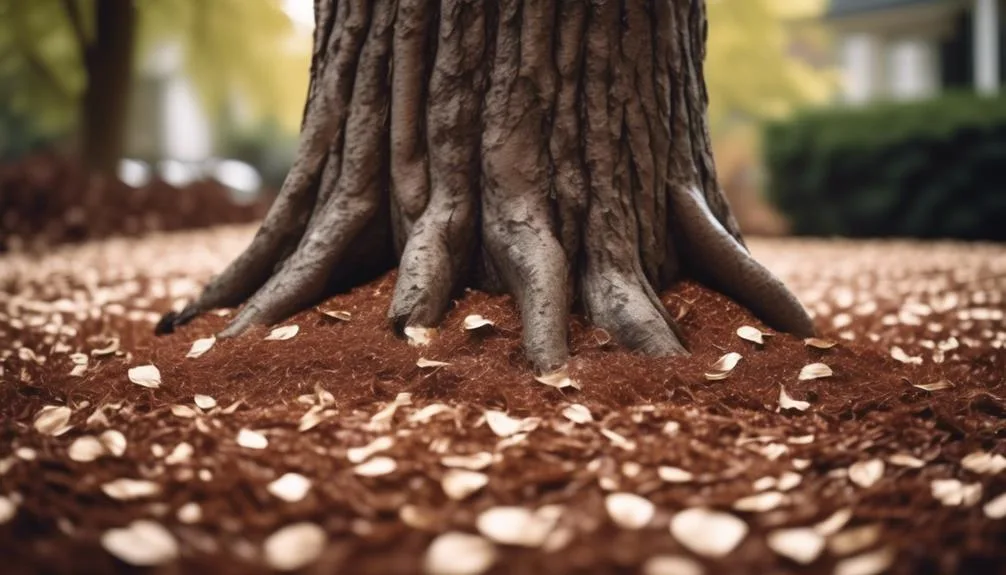Dogwood trees need the right mulch to stay healthy. Different mulch types affect their well-being. Choosing the best one is important.
Learn about organic and inorganic mulches and how they can impact your trees. Discover the top mulches that protect and beautify your dogwood trees.
Organic Mulches for Dogwood Trees
For healthy and thriving dogwood trees, consider using organic mulches to retain moisture, suppress weeds, and improve soil fertility. When selecting mulch for your dogwood trees, look for organic options such as compost, wood chips, or pine straw.
These mulches not only help to conserve soil moisture by reducing evaporation, but they also inhibit the growth of pesky weeds that compete with your dogwood tree for water and nutrients. Additionally, organic mulches gradually break down over time, releasing valuable nutrients into the soil and improving its overall fertility.
This natural decomposition process also encourages beneficial microbial activity in the soil, creating a healthier environment for your dogwood tree's roots. By choosing the right organic mulch, you can provide essential benefits to support the growth and vitality of your dogwood trees.
Inorganic Mulches for Dogwood Trees
Consider the benefits of inorganic mulches for your dogwood trees, as they offer alternative options for moisture retention, weed suppression, and soil improvement.
Inorganic mulch benefits include:
- Durability: Inorganic mulches such as gravel or stone can last for years, providing long-term weed control and moisture retention.
- Heat Retention: These mulches absorb and retain heat, creating a warm microclimate beneficial for the roots of dogwood trees, especially in cooler climates.
- Aesthetic Appeal: Inorganic mulches can enhance the visual appeal of your garden with their diverse textures and colors.
When applying inorganic mulches, ensure proper installation techniques such as using landscape fabric to prevent weed growth and applying a layer of the mulch to a depth of 2-4 inches, being careful not to mound it against the tree trunk.
Natural Mulch Vs. Synthetic Mulch
When choosing mulch for your dogwood trees, you'll want to weigh the benefits of natural mulch against those of synthetic mulch to determine the best option for your specific gardening needs.
Natural mulch, such as wood chips or bark, is environmentally friendly, as it decomposes over time, enriching the soil and providing nutrients to the trees. It also helps in retaining moisture and regulating soil temperature.
On the other hand, synthetic mulch, like rubber or plastic, offers cost efficiency as it lasts longer and requires less frequent replacement. However, it doesn't contribute to soil health and may have an adverse environmental impact.
Consider the long-term benefits of natural mulch for the environment and soil health versus the durability and upfront cost efficiency of synthetic mulch when making your decision.
Mulching Tips for Dogwood Trees
To ensure the health and vitality of your dogwood trees, it's essential to understand effective mulching tips that complement the natural benefits of organic mulch and address the concerns associated with synthetic mulch. Here are some essential mulching tips for your dogwood trees:
- Proper Mulching Techniques
- Applying a 2- to 4-inch layer of mulch around the base of the tree, keeping it a few inches away from the trunk to prevent moisture-related issues.
- Raking and fluffing the mulch periodically to ensure proper aeration and prevent the formation of mold or mildew.
- Ideal Timing for Mulching
- Mulch in early spring to help retain soil moisture during the growing season.
- Reapply mulch in late fall to provide insulation and protection during winter.
Best Practices for Mulching Dogwood Trees
Mulching your dogwood trees with the right techniques can significantly contribute to their overall health and vigor. Proper mulching provides various benefits, such as moisture retention, weed suppression, and insulation from extreme temperatures. When applying mulch around your dogwood trees, it's essential to follow best practices to ensure their optimal growth and well-being. Here are some key tips for mulch application:
| Mulching Benefits | Mulch Application |
|---|---|
| Retains soil moisture | Apply mulch in a 2-4 inch layer, keeping it 3 inches away from the tree trunk to prevent rot |
| Suppresses weeds | Extend mulch to the tree's drip line to cover the entire root zone |
| Insulates roots from temperature extremes | Replenish mulch annually to maintain the desired depth and benefits |
Following these best practices will help you maximize the benefits of mulching for your dogwood trees.
Conclusion
To ensure the health and growth of your dogwood trees, choose the right mulch wisely.
Organic options like wood chips and shredded bark offer nutrients and soil improvement, while inorganic choices like gravel and stones provide weed control and moisture retention.
Consider the benefits of natural versus synthetic mulch and follow best mulching practices for thriving dogwood trees in your landscape.

My interest in trees started when I first saw the giant sequoias in Yosemite.
I was a teenager then, and I remember thinking, “I need to learn more about this.”
That moment stuck with me.
A few years later, I went on to study forestry at Michigan Tech.
Since graduating, I’ve worked in a mix of hands-on tree care and community education.
I’ve spent over ten years helping people understand how to plant, maintain, and protect the trees in their neighborhoods.
I don’t see trees as just part of the landscape.
They are living things that make a real difference in our daily lives.
